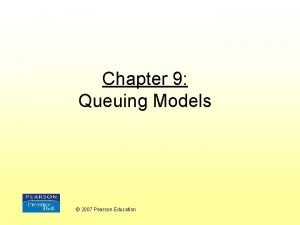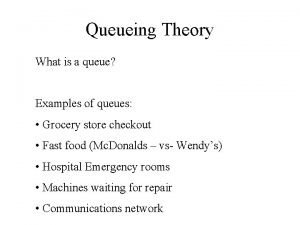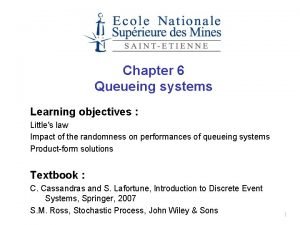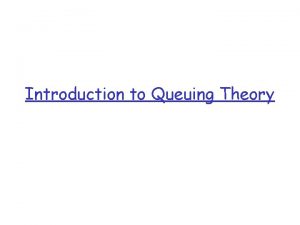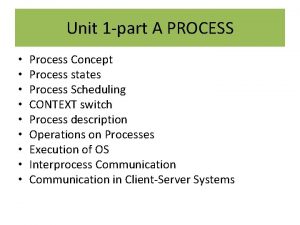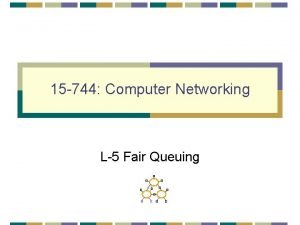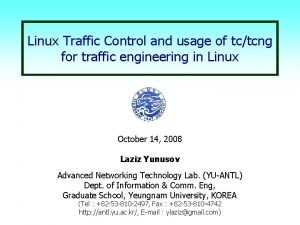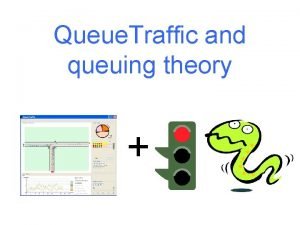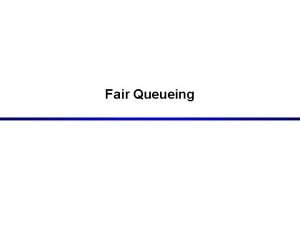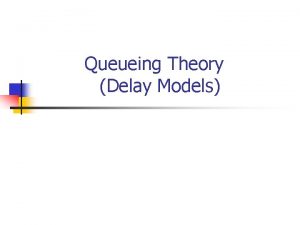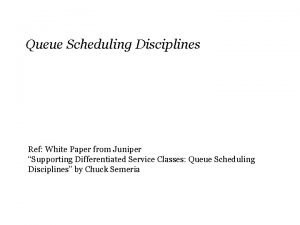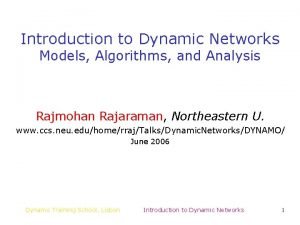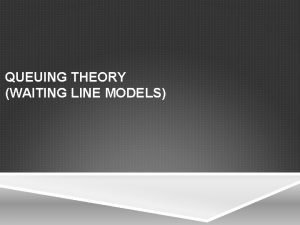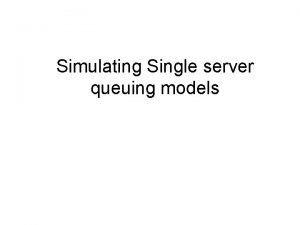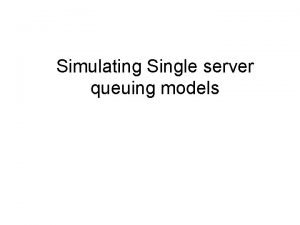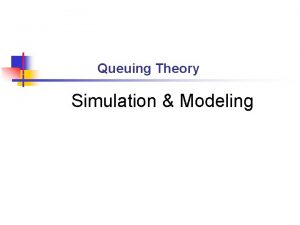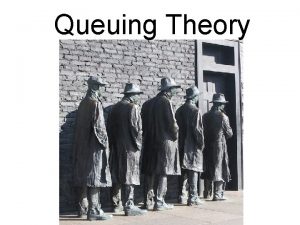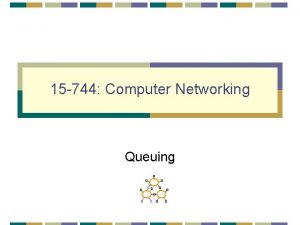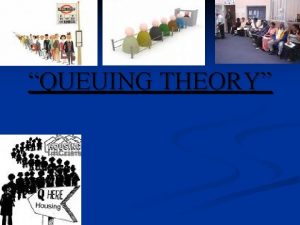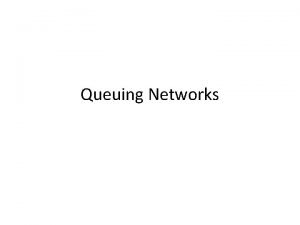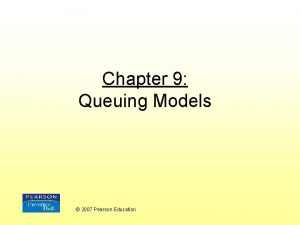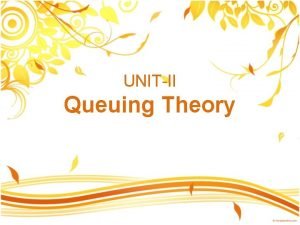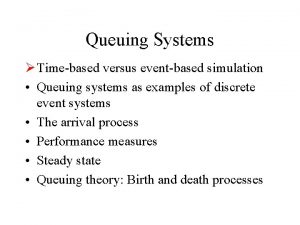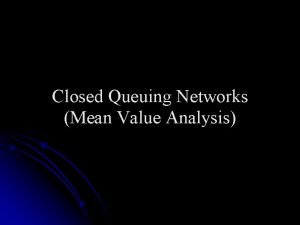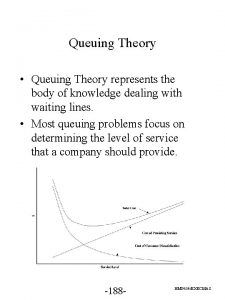Simulating Single server queuing models Simulating Single server

















- Slides: 17

Simulating Single server queuing models

Simulating Single server queuing models • Consider the following sequence of activities that each customer undergoes: 1. Customer arrives 2. Customer waits for service if the server is busy. 3. Customer receives service. 4. Customer departs the system.

Example • Arrival rate (l =15) customers per hour • Service time = 3 minutes (service rate (m= 20) customer per hour Arrival and Service times are exponentially distributed Note: the generation of Exponential Random Variable is: – Generate uniform [0, 1] RN: RAND() – Return X = -1/l * ln(RAND())

Analytical Solutions • Analytical solutions for W, L, Wq, Lq exist (see Lecture 05) • However, analytical solution exist at infinity which cannot be reached. • Therefore, Simulation is a most.

Flowchart of an arrival event An Arrival Idle Busy Status of Server Customer enters service Customer joins queue More

Flowchart of a Departure event A Departure NO Queue Empty ? Remove customer from Queue and begin service Yes Set system status to idle More

An example of a hand simulation • Consider the following IAT’s and ST’s: • A 1=0. 4, A 2=1. 2, A 3=0. 5, A 4=1. 7, A 5=0. 2, A 6=1. 6, A 7=0. 2, A 8=1. 4, A 9=1. 9, … • S 1=2. 0, S 2=0. 7, S 3=0. 2, S 4=1. 1, S 5=3. 7, S 6=0. 6 • Want: Average delay in queue • Utilization

Initialization Time = 0 System state Server 0 Clock 0 Server status system 0 # in que Times of Arrival 0. 4 A D 999 Eventlist 0 Time 0 0 Of Last Number Total event delayed delay 0 Area Under Q(t) Statistical Counters 0 Area Under B(t)

Arrival Time = 0. 4 System state 0. 4 Clock 0. 4 system 1 Server status 0 # in que Times of Arrival A 1. 6 D 2. 4 Eventlist 0. 4 Time 1 0 Of Last Number Total event delayed delay 0 Area Under Q(t) Statistical Counters 0 Area Under B(t) A 1=0. 4, A 2=1. 2, A 3=0. 5, A 4=1. 7, A 5=0. 2, A 6=1. 6, A 7=0. 2, A 8=1. 4 S 1=2. 0, S 2=0. 7, S 3=0. 2, S 4=1. 1, S 5=3. 7, S 6=0. 6

Arrival Time = 1. 6 System state 1. 6 Clock 0. 4 1 1. 6 system Server status 1 # in que Times of Arrival A 2. 1 D 2. 4 Eventlist 1. 6 Time 0 1 Of Last Number Total event delayed delay 0 Area Under Q(t) Statistical Counters 1. 2 Area Under B(t) A 1=0. 4, A 2=1. 2, A 3=0. 5, A 4=1. 7, A 5=0. 2, A 6=1. 6, A 7=0. 2, A 8=1. 4 S 1=2. 0, S 2=0. 7, S 3=0. 2, S 4=1. 1, S 5=3. 7, S 6=0. 6

Arrival Time = 2. 1 System state 1. 6 2. 1 0. 4 1 1. 6 2. 1 System 2. 1 Clock Server status 2 # in que Times of Arrival A 3. 8 D 2. 4 Eventlist 2. 1 Time 0 1 Of Last Number Total event delayed delay 0. 5 Area Under Q(t) Statistical Counters 1. 7 Area Under B(t) A 1=0. 4, A 2=1. 2, A 3=0. 5, A 4=1. 7, A 5=0. 2, A 6=1. 6, A 7=0. 2, A 8=1. 4 S 1=2. 0, S 2=0. 7, S 3=0. 2, S 4=1. 1, S 5=3. 7, S 6=0. 6

Departure Time = 2. 4 System state 2. 1 2. 4 Clock 1. 6 1 2. 1 System Server status 1 # in que Times of Arrival A 3. 8 D 3. 1 Eventlist 2. 4 Time 2 0. 8 Of Last Number Total event delayed delay 1. 1 Area Under Q(t) Statistical Counters 2. 0 Area Under B(t) A 1=0. 4, A 2=1. 2, A 3=0. 5, A 4=1. 7, A 5=0. 2, A 6=1. 6, A 7=0. 2, A 8=1. 4 S 1=2. 0, S 2=0. 7, S 3=0. 2, S 4=1. 1, S 5=3. 7, S 6=0. 6

Departure Time = 3. 1 System state 3. 1 Clock 2. 1 1 Server status System 0 # in que Times of Arrival A 3. 8 D 3. 3 Eventlist 3. 1 Time 3 1. 8 Of Last Number Total event delayed delay 1. 8 Area Under Q(t) Statistical Counters 2. 7 Area Under B(t) A 1=0. 4, A 2=1. 2, A 3=0. 5, A 4=1. 7, A 5=0. 2, A 6=1. 6, A 7=0. 2, A 8=1. 4 S 1=2. 0, S 2=0. 7, S 3=0. 2, S 4=1. 1, S 5=3. 7, S 6=0. 6

Departure Time = 3. 1 System state 3. 3 Clock 0 Server status System 0 # in que Times of Arrival A 3. 8 D 999. Eventlist 3. 3 Time 3 1. 8 Of Last Number Total event delayed delay 1. 8 Area Under Q(t) Statistical Counters 2. 9 Area Under B(t) A 1=0. 4, A 2=1. 2, A 3=0. 5, A 4=1. 7, A 5=0. 2, A 6=1. 6, A 7=0. 2, A 8=1. 4 S 1=2. 0, S 2=0. 7, S 3=0. 2, S 4=1. 1, S 5=3. 7, S 6=0. 6

Departure Time = 3. 1 System state 3. 8 Clock 3. 8 1 Server status System 0 # in que Times of Arrival A 4. 0 D 4. 9 Eventlist 3. 8 Time 4 1. 8 Of Last Number Total event delayed delay 1. 8 Area Under Q(t) Statistical Counters 2. 9 Area Under B(t) A 1=0. 4, A 2=1. 2, A 3=0. 5, A 4=1. 7, A 5=0. 2, A 6=1. 6, A 7=0. 2, A 8=1. 4 S 1=2. 0, S 2=0. 7, S 3=0. 2, S 4=1. 1, S 5=3. 7, S 6=0. 6

Departure Time = 3. 1 System state 4. 0 3. 8 4. 0 System 1 Server status 1 # in que Times of Arrival 4. 0 Clock A 5. 6 D 4. 9 Eventlist 4. 0 Time 4 1. 8 Of Last Number Total event delayed delay 1. 8 Area Under Q(t) Statistical Counters 3. 1 Area Under B(t) A 1=0. 4, A 2=1. 2, A 3=0. 5, A 4=1. 7, A 5=0. 2, A 6=1. 6, A 7=0. 2, A 8=1. 4 S 1=2. 0, S 2=0. 7, S 3=0. 2, S 4=1. 1, S 5=3. 7, S 6=0. 6

Departure Time = 3. 1 System state 4. 9 Clock 4. 0 1 Server status System 0 # in que Times of Arrival A 5. 6 D 8. 6 Eventlist 4. 9 Time 5 2. 7 Of Last Number Total event delayed delay 2. 7 4. 0 Area Under Q(t) B(t) Statistical Counters A 1=0. 4, A 2=1. 2, A 3=0. 5, A 4=1. 7, A 5=0. 2, A 6=1. 6, A 7=0. 2, A 8=1. 4 S 1=2. 0, S 2=0. 7, S 3=0. 2, S 4=1. 1, S 5=3. 7, S 6=0. 6
 Kendall's notation
Kendall's notation Foamy liver is seen in putrefaction
Foamy liver is seen in putrefaction Postmortem signs
Postmortem signs Random early drop
Random early drop Queueing theory
Queueing theory Kingmans formula
Kingmans formula Queuing theory definition
Queuing theory definition Queuing diagram representation of process scheduling
Queuing diagram representation of process scheduling Queuing discipline in computer networks
Queuing discipline in computer networks Priority queuing
Priority queuing Queuing theory
Queuing theory Analysis
Analysis Queuing delay
Queuing delay Wfq
Wfq Mm1 queue
Mm1 queue Deficit weighted round robin
Deficit weighted round robin Queuing theory
Queuing theory At a certain petrol pump customers arrive
At a certain petrol pump customers arrive
